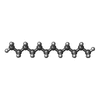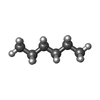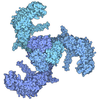+ Open data
Open data
- Basic information
Basic information
| Entry | Database: PDB / ID: 9c07 | |||||||||||||||||||||
|---|---|---|---|---|---|---|---|---|---|---|---|---|---|---|---|---|---|---|---|---|---|---|
| Title | Structure of K2P13.1 (THIK1) S136P in detergent | |||||||||||||||||||||
 Components Components | Potassium channel subfamily K member 13 | |||||||||||||||||||||
 Keywords Keywords | TRANSPORT PROTEIN / Potassium channel / K2P channel | |||||||||||||||||||||
| Function / homology |  Function and homology information Function and homology informationregulation of excitatory synapse pruning / Tandem pore domain halothane-inhibited K+ channel (THIK) / regulation of NLRP3 inflammasome complex assembly / Phase 4 - resting membrane potential / potassium ion leak channel activity / regulation of resting membrane potential / outward rectifier potassium channel activity / monoatomic ion channel complex / potassium channel activity / potassium ion transmembrane transport ...regulation of excitatory synapse pruning / Tandem pore domain halothane-inhibited K+ channel (THIK) / regulation of NLRP3 inflammasome complex assembly / Phase 4 - resting membrane potential / potassium ion leak channel activity / regulation of resting membrane potential / outward rectifier potassium channel activity / monoatomic ion channel complex / potassium channel activity / potassium ion transmembrane transport / protein heterodimerization activity / metal ion binding / identical protein binding / plasma membrane Similarity search - Function | |||||||||||||||||||||
| Biological species |  Homo sapiens (human) Homo sapiens (human) | |||||||||||||||||||||
| Method | ELECTRON MICROSCOPY / single particle reconstruction / cryo EM / Resolution: 2.73 Å | |||||||||||||||||||||
 Authors Authors | Roy-Chowdhury, S. / Adberemane-Ali, F. / Minor, D.L. | |||||||||||||||||||||
| Funding support |  United States, 1items United States, 1items
| |||||||||||||||||||||
 Citation Citation |  Journal: Nat Struct Mol Biol / Year: 2025 Journal: Nat Struct Mol Biol / Year: 2025Title: Structure of the human K13.1 channel reveals a hydrophilic pore restriction and lipid cofactor site. Authors: Shatabdi Roy-Chowdhury / Seil Jang / Fayal Abderemane-Ali / Fiona Naughton / Michael Grabe / Daniel L Minor /  Abstract: Polyunsaturated fatty acid (PUFA) lipids modulate the neuronal and microglial leak potassium channel K13.1 (THIK1) and other voltage-gated ion channel (VGIC) superfamily members through poorly ...Polyunsaturated fatty acid (PUFA) lipids modulate the neuronal and microglial leak potassium channel K13.1 (THIK1) and other voltage-gated ion channel (VGIC) superfamily members through poorly understood mechanisms. Here we present cryo-electron microscopy structures of human THIK1 and mutants, revealing a unique two-chamber aqueous inner cavity obstructed by a hydrophilic barrier important for gating, the flow restrictor, and a P1-M4 intersubunit interface lipid at a site, the PUFA site, corresponding to the K small-molecule modulator pocket. This overlap, together with functional studies, indicates that PUFA site lipids are THIK1 cofactors. Comparison with a PUFA-responsive VGIC, K7.1, reveals a shared modulatory role for the pore domain intersubunit interface, providing a framework for understanding PUFA action on the VGIC superfamily. Our findings reveal the distinct THIK1 architecture, highlight the importance of the P1-M4 interface for K control by natural and synthetic ligands and should aid in the development of THIK subfamily modulators for neuroinflammation and autism. | |||||||||||||||||||||
| History |
|
- Structure visualization
Structure visualization
| Structure viewer | Molecule:  Molmil Molmil Jmol/JSmol Jmol/JSmol |
|---|
- Downloads & links
Downloads & links
- Download
Download
| PDBx/mmCIF format |  9c07.cif.gz 9c07.cif.gz | 136.2 KB | Display |  PDBx/mmCIF format PDBx/mmCIF format |
|---|---|---|---|---|
| PDB format |  pdb9c07.ent.gz pdb9c07.ent.gz | 108.7 KB | Display |  PDB format PDB format |
| PDBx/mmJSON format |  9c07.json.gz 9c07.json.gz | Tree view |  PDBx/mmJSON format PDBx/mmJSON format | |
| Others |  Other downloads Other downloads |
-Validation report
| Summary document |  9c07_validation.pdf.gz 9c07_validation.pdf.gz | 1.1 MB | Display |  wwPDB validaton report wwPDB validaton report |
|---|---|---|---|---|
| Full document |  9c07_full_validation.pdf.gz 9c07_full_validation.pdf.gz | 1.1 MB | Display | |
| Data in XML |  9c07_validation.xml.gz 9c07_validation.xml.gz | 30.4 KB | Display | |
| Data in CIF |  9c07_validation.cif.gz 9c07_validation.cif.gz | 41.7 KB | Display | |
| Arichive directory |  https://data.pdbj.org/pub/pdb/validation_reports/c0/9c07 https://data.pdbj.org/pub/pdb/validation_reports/c0/9c07 ftp://data.pdbj.org/pub/pdb/validation_reports/c0/9c07 ftp://data.pdbj.org/pub/pdb/validation_reports/c0/9c07 | HTTPS FTP |
-Related structure data
| Related structure data |  45075MC  9bsnC  9bwsC  9byiC  9c09C C: citing same article ( M: map data used to model this data |
|---|---|
| Similar structure data | Similarity search - Function & homology  F&H Search F&H Search |
- Links
Links
- Assembly
Assembly
| Deposited unit | 
|
|---|---|
| 1 |
|
- Components
Components
-Protein , 1 types, 2 molecules UA
| #1: Protein | Mass: 39383.613 Da / Num. of mol.: 2 Fragment: K2P13.1 (THIK1) residues 1 to 350 followed by SNS linker and 3c protease cleavage site Mutation: N59Q. N65Q, S136P Source method: isolated from a genetically manipulated source Source: (gene. exp.)  Homo sapiens (human) / Gene: KCNK13 / Production host: Homo sapiens (human) / Gene: KCNK13 / Production host:  Homo sapiens (human) / References: UniProt: Q9HB14 Homo sapiens (human) / References: UniProt: Q9HB14 |
|---|
-Non-polymers , 6 types, 36 molecules 










| #2: Chemical | ChemComp-D12 / #3: Chemical | ChemComp-OCT / #4: Chemical | ChemComp-HEX / #5: Chemical | #6: Chemical | #7: Chemical | ChemComp-K / |
|---|
-Details
| Has ligand of interest | Y |
|---|---|
| Has protein modification | N |
-Experimental details
-Experiment
| Experiment | Method: ELECTRON MICROSCOPY |
|---|---|
| EM experiment | Aggregation state: PARTICLE / 3D reconstruction method: single particle reconstruction |
- Sample preparation
Sample preparation
| Component | Name: homodimer of K2P13.1 (THIK1) S136P mutant / Type: COMPLEX / Entity ID: #1 / Source: RECOMBINANT |
|---|---|
| Molecular weight | Experimental value: NO |
| Source (natural) | Organism:  Homo sapiens (human) Homo sapiens (human) |
| Source (recombinant) | Organism:  Homo sapiens (human) Homo sapiens (human) |
| Buffer solution | pH: 7.8 |
| Specimen | Embedding applied: NO / Shadowing applied: NO / Staining applied: NO / Vitrification applied: YES |
| Specimen support | Grid material: GOLD / Grid mesh size: 300 divisions/in. / Grid type: Quantifoil R1.2/1.3 |
| Vitrification | Cryogen name: ETHANE / Humidity: 100 % / Chamber temperature: 277.15 K |
- Electron microscopy imaging
Electron microscopy imaging
| Experimental equipment |  Model: Titan Krios / Image courtesy: FEI Company |
|---|---|
| Microscopy | Model: FEI TITAN KRIOS |
| Electron gun | Electron source:  FIELD EMISSION GUN / Accelerating voltage: 300 kV / Illumination mode: FLOOD BEAM FIELD EMISSION GUN / Accelerating voltage: 300 kV / Illumination mode: FLOOD BEAM |
| Electron lens | Mode: BRIGHT FIELD / Nominal defocus max: 2000 nm / Nominal defocus min: 800 nm |
| Specimen holder | Cryogen: NITROGEN / Specimen holder model: FEI TITAN KRIOS AUTOGRID HOLDER |
| Image recording | Electron dose: 46 e/Å2 / Film or detector model: GATAN K3 (6k x 4k) |
- Processing
Processing
| EM software |
| ||||||||||||
|---|---|---|---|---|---|---|---|---|---|---|---|---|---|
| CTF correction | Type: NONE | ||||||||||||
| Symmetry | Point symmetry: C2 (2 fold cyclic) | ||||||||||||
| 3D reconstruction | Resolution: 2.73 Å / Resolution method: FSC 0.143 CUT-OFF / Num. of particles: 508529 / Symmetry type: POINT |
 Movie
Movie Controller
Controller







 PDBj
PDBj









